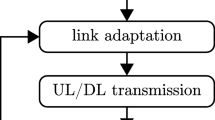Abstract
The paper describes three relevant perspectives on current wireless simulation practices. In order to obtain the key challenges for future network simulations, the characteristics of “beyond 3G” networks are described, including their impact on simulation.
Similar content being viewed by others
References
T.C.W. Schenk and A. van Zelst, “Frequency Synchronization for MIMO OFDM Wireless LAN Systems,” in Proc. IEEE Vehicular Technology Conference Fall 2003 (VTC Fall 2003), Orlando (FL), Oct. 2003, Vol. 2, pp. 781–785.
T.C.W. Schenk, X.-J. Tao, P.F.M. Smulders, and E.R. Fledderus, “Influence and Suppression of Phase Noise in Multi-Antenna OFDM,” in Proc. IEEE Vehicular Technology Conference Fall 2004 (VTC Fall 2004), Los Angeles (CA), pp. 26–29 Sept. 2004.
E.R. Fledderus, “Mathematical Modelling in the UMTS Planning Process: The Concept of Effective Bandwidth,” in Proc. of “Workshop on IP and Related Issues to UMTS/IMT-2000, Aalborg University, August 2000.
T. Neubauer, “Achieving Rapid 3G Capacity and Coverage Enhancement Through Automated Antenna Optimization Techniques,” Cell Planning Conference, Prague, 2004.
E.R. Fledderus, M. Rijken, and J.C. van der Wal, “Remote Electrical Downtilt”, TNO Telecom report no 33530, 2005.
B. Boltjes, I.F. Fernandez, B.A. Kock, R.J.G.M. Langeveld, and G. Schoenmaker, “Validation and Adaptation of Router and Switch Models,” in Proc. of the Conference OPNETWORK, 26–30 August 2002, Washington, DC.
M.J. Fleuren, H. Stüben, and G.F. Zegwaard, “MoDySim – A parallel Dynamic UMTS Simulator”, in Proc. of PARCO 2003, Dresden.
IST-MOMENTUM, http://momentum.zib.de.
Paper from Ignas Niemegeers in this issue.
Author information
Authors and Affiliations
Corresponding author
Additional information
Erik Fledderus (1970) received a PhD in Applied Mathematics in 1997, after which he started working at KPN Research, which merged with TNO in January 2003. He developed the basis for UMTS radio network planning at KPN, and initiated in 2000 a European project proposal, Momentum, in the area of UMTS radio planning and simulation, with 7 partners from Germany and Pottugal. Erik acted as project leader and co-ordinator from 2001-2003. Also at the end of 2000 he initiated together with Eindhoven University of Technology, Agere Systems and Philips Research a research proposal in the area of antenna arrays and MIMO in WLAN and UMTS. One of the results of this project~lies at the basis for the 802.11n-proposal by Agere/Philips.
Since March 1st 2003, Erik is part-time professor at Eindhoven University of Technology in the field of Wireless Communication Networks.
Within TNO he is senior strategist, program manager of the program Future ICT Architectures, and leading in the knowledge management regarding radio and mobile network technology, and strategist on mobile/wireless technology in general.
Rights and permissions
About this article
Cite this article
Fledderus, E.R. Wireless Network Simulation – Your Window on Future Network Performance. Wireless Pers Commun 33, 319–325 (2005). https://doi.org/10.1007/s11277-005-0575-0
Issue Date:
DOI: https://doi.org/10.1007/s11277-005-0575-0




